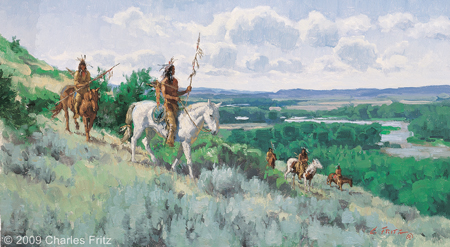Absaroka Scouts, Elk River
10″ x 18″ oil on board
© 2009 by Charles Fritz, http://charlesfritz.com. Used by permission.
In the list of names and descriptions of North American tribes that Lewis and Clark compiled at Fort Mandan, they called the people living along the Yellowstone River, “as usially Spelt and pronounc’d” by the English—and in Clark’s idiosyncratic spelling—”Ravin nation.” Clark wrote the “primitive” name phonetically as Arp-Sar-co-gah, and gave the nickname that “generally obtained among the Canadian Traders as “Cor beaus” (i.e., corbeaux, French for “crows” or “ravens”). But the people called themselves Absalookas, sometimes heard as Absarokas, or “Children of the Large-beaked Bird.” Various early white travelers transcribed or defined the name differently, but the Absalookas maintain it refers to the raven. Naturally, the Plains Sign Language gesture for them is the flapping the arms like wings.[1]Douglas R. Parks, Handbook of North American Indians: Plains Vol. 13, ed. Raymond J. DeMallie (Washington, D.C.: Smithsonian Institution, 2001), 715.
Starting in the late 1600s, perhaps earlier, the Crows began a gradual process of separation with the Hidatsas. The Mountain Crow and Awatixa Hidatsa share a common ancestry as do the River Crow with the Hidatsa proper.[2]Fred W. Voget, Handbook of North American Indians: Plains Vol. 13, 695. At the time of the expedition, the two nations maintained annual visits, and Toussaint Charbonneau and his wife, Sacagawea, would likely have known, and be known by, many Crow individuals. During the expedition, no one would see any Crow people, but those people certainly noticed the expedition passing through their lands.
While exploring the Yellowstone, the travelers did see signs of Crow. When horses starting disappearing during the night at Yellowstone Canoe Camp, unseen Crow thieves were suspected. Clark’s speech imploring the return of his horses never found its intended audience. In a final encounter, the remaining horses were stolen from Sgt. Nathaniel Pryor‘s small group who were charged with taking them to the Knife River Villages as currency in a bold diplomatic plan.
In the “Estimate of the Eastern Indians,” Clark explains the role the Crow played in trade between the Shoshones, who traded with the Spanish, and the Knife River Villages and Hidatsas, who traded with the North West and Hudson’s Bay companies:
These people are divided into four bands, called by themselves A-hâh’-âr-ro’-pit-no-pah, Noo’-ta, Pa-rees-car, and E-hârt’-sâr. They annually visit the Mandans, Minetares [Hidatsas], and Ahwahhaways [Iowas], to whom they barter horses, mules, leather lodges, and many articles of Indian apparel, for which they receive, in return, guns, ammunition, axes, kettles, awls, and other European manufactures. When they return to their country, they are in turn visited by the Paunch and Snake Indians, to whom they barter most of the articles they have obtained from the nations on the Missouri, for horses and mules, of which those nations have a greater abundance than themselves. They also obtain from the Snake Indians, bridle-bits and blankets, and some other articles which those Indians purchase from the Spaniards. The bridle-bits and blankets I have seen in the possession of the Mandans and Minetares.[3]Moulton, Journals, 3:428.
Today, the Crow have one federally recognized tribe, the Crow Tribe of Montana, and many of the people’s ways and language, including their horse culture, are relatively well-preserved.
Selected Pages and Encounters
October 12, 1804
More Arikara diplomacy
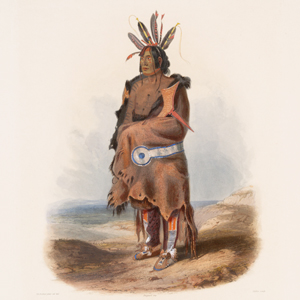
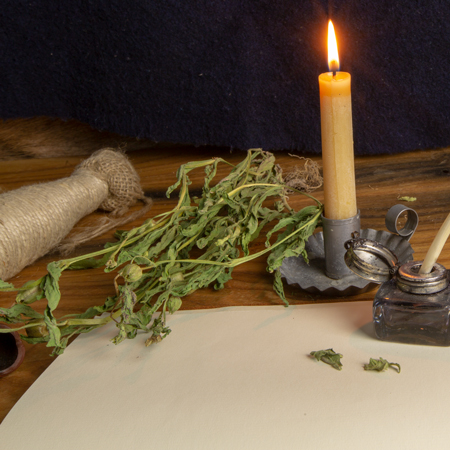
Shaw Creek Rec. Area, SD The morning is spent parleying and trading with the Arikaras. At 1 pm, with the sounding horn and fiddle playing, the expedition heads up the Missouri River.
August 18, 1806
A Mandan history lesson
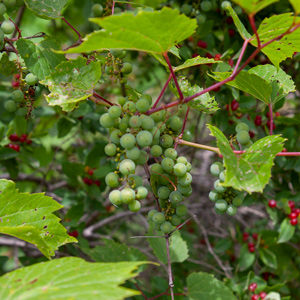

Below the Heart River, ND Despite windy conditions, the expedition makes forty miles. As they pass abandoned village sites, Chief Sheheke (Big White) tells Clark of his people’s history. Near the Heart River, he tells the Mandan creation story.
August 31, 1804
Yankton speeches
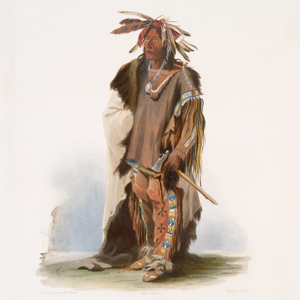

Yankton, SD In the morning, the council with the Yankton Sioux continues. Several Sioux give speeches, and Clark and Ordway take notes. Dorion is assigned a diplomatic mission and leaves with the Yanktons.
March 8, 1805
Rocky Mountain Indians
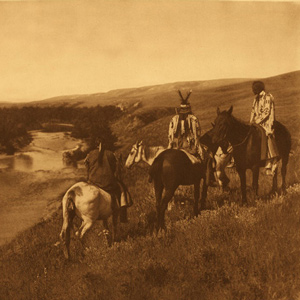

Fort Mandan, ND Visiting Indians inform Clark about “the Indians near the rockey mountains” and tell how the Black Man retrieved his kidnapped daughter.
July 21, 1806
A spate of missing horses
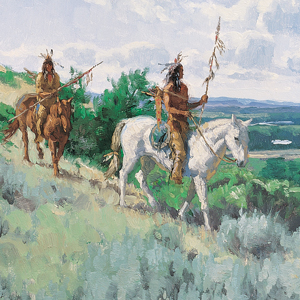

On the Yellowstone, half of Clark’s horses appear to be stolen by Crow Indians. Above the Falls of the Missouri, missing horses delay the portage. On the Marias, Lewis turns up Cut Bank Creek.
July 19, 1806
Beached dugouts
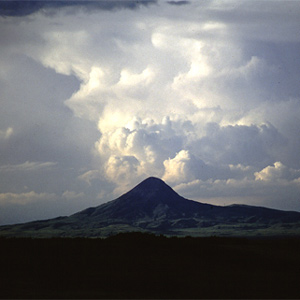

On the Yellowstone, Clark finds trees for making canoes and attends to Pvt. Gibson’s wound. Lewis moves up the Marias River, while at the Great Falls of the Missouri, Sgts. Ordway and Gass beach the dugouts.
July 18, 1806
Smoke signals
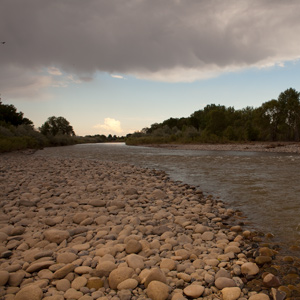

On the Yellowstone, Clark sees smoke and suspects that the Crows have discovered them. To the north, Lewis arrives at the Marias River, Gass visits Lower Portage Camp, and Ordway nears the Falls of the Missouri.
July 22, 1806
Lewis's great disappointment
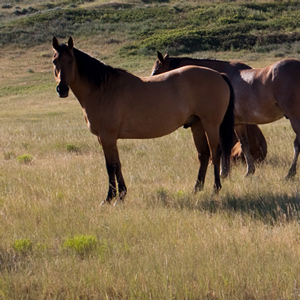

Detachments at the Yellowstone River Canoe Camp and Great Falls of the Missouri search for missing horses. Lewis sees that Cut Bank Creek does not go north and stops to hunt and make celestial observations.
Crow Country
by Joseph A. Mussulman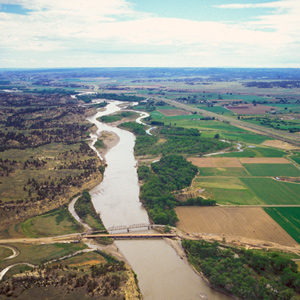

The Crows called themselves Absalookas, sometimes heard as Absarokas, or “Children of the Large-beaked Bird.”
August 13, 1805
Shoshone diplomacy
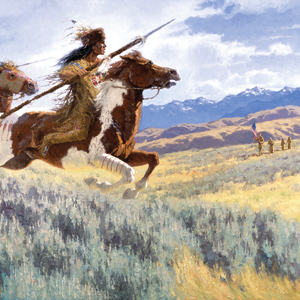

Shoshone Village, ID and Clark’s Lookout, MT In the Lemhi River valley, Shoshone diplomacy includes greetings, a flag presentation, a pipe ceremony, and revelry late into the night. Back on the Beaverhead River, Clark takes bearings from Clark’s Lookout, and several men fish.
July 24, 1806
Pryor's mission begins
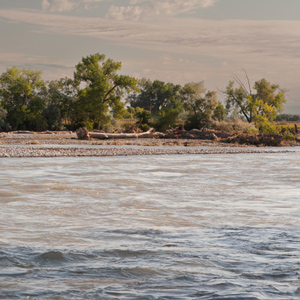

Clark’s group paddles 70 miles down the Yellowstone while Sgt. Pryor leaves for the Knife River Villages with the horses. Lewis remains at Camp Disappointment and at the Great Falls, the portage continues.
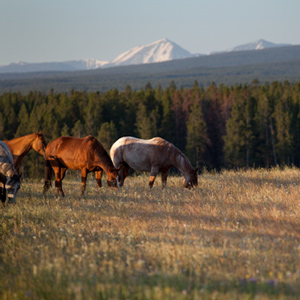

Pryor and six privates had successfully driven forty-one horses all the way to the Yellowstone Valley, apparently without any trouble. Then, smoke on the horizon. Twenty-four horses stolen on the twentieth. Seventeen taken on the twenty-fifth.
July 26, 1806
A Blackfeet interview
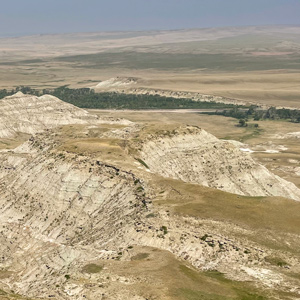

On the Two Medicine River, Lewis is joined by several young Blackfeet. All of Pryor’s horses are stolen, and the portage of the Great Falls of the Missouri is completed. Clark explores the Bighorn River.
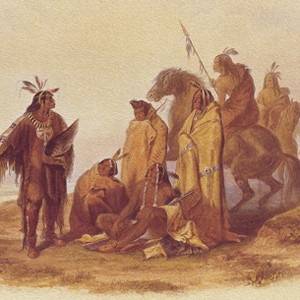

While stinging from having so many of his horses stolen, Clark wrote a speech to the Crow Indians imploring them to return the booty. After all, he needed those horses to complete the captain’s bold diplomatic plan.
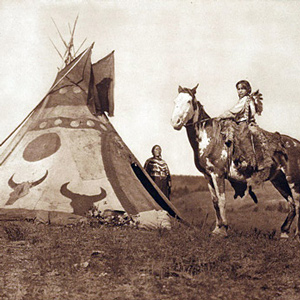

Beginning with the Fort Laramie Treaty of 1851, the U.S. government set the vast area north of the Missouri (approximately 20 million acres) aside as the “Blackfeet Hunting Ground” for the Blackfeet and other tribes—Cree, Assiniboine, Gros Ventre, and Sioux.
May 11, 1806
Council at Lawyer Creek
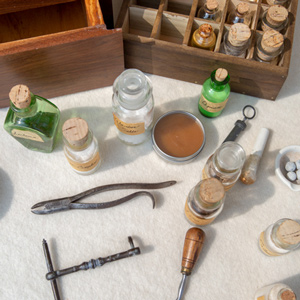

Lawyer Creek near Kamiah, ID With four major Nez Perce chiefs present, the captains continue their council at Lawyer Creek. After that, they demonstrate the air gun and magnets; and provide medical aid to several applicants.
August 30, 1804
Yankton council and dance
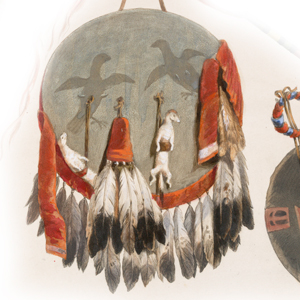

Yankton, SD The captains spend all morning preparing for a council, and then have the Yankton Sioux representatives brought over from across the river. Clark learns about the Akicita Society.
July 17, 1806
Signs of danger
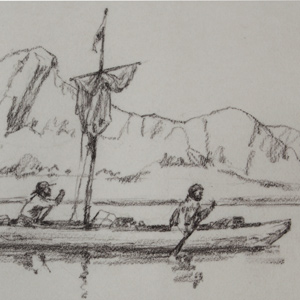

Between the Falls of the Missouri and the Marias River, Lewis sees signs of Indian hunters. On the Yellowstone, Clark passes an “Indian Fort”. Sgt. Ordway runs Pine Tree Rapids and Sgt. Gass waits above the falls.
July 23, 1806
Blackfeet and Crow near
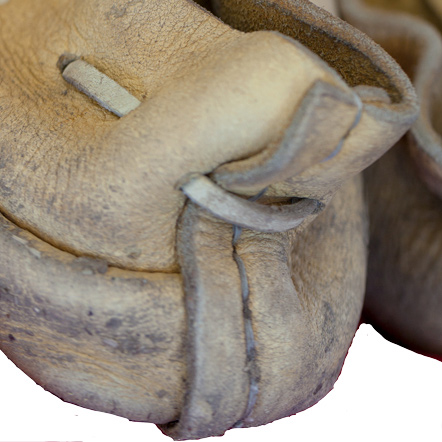

At Camp Disappointment, clouds prevent Lewis from making celestial observations. Clark’s group is ready to paddle down the Yellowstone, and another detachment portages around the Falls of the Missouri.
November 12, 1804
Mandan history lesson
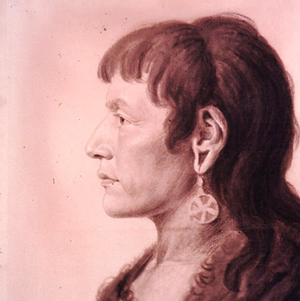

Fort Mandan, ND Sheheke (Big White), chief of the Mitutanka village, and his wife, likely Yellow Corn, visit Fort Mandan. She carries 100 pounds of meat and Sheheke tells the Mandan creation story.
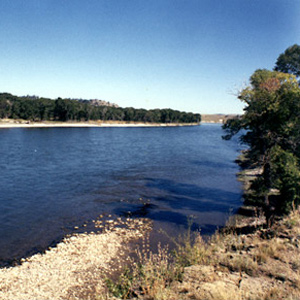

“This smoke must be raisd. by the Crow Indians in that direction as a Signal for us, or other bands. I think it most probable that they have discovered our trail.”
